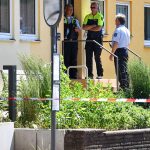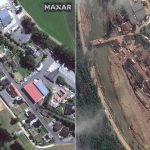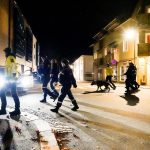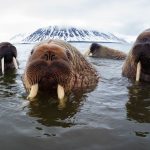Record-breaking numbers of visitors have travelled to see a spectacular volcano eruption in Iceland – which has been captured on camera.
Thousands of people headed to the Reykjanes Peninsula near the town of Grindavik, around 19 miles (30km) southwest of the capital Reykjavík, to catch a glimpse of the orange-hued display.
Some visitors were even pictured grilling food on the scorching crust of magma as they soaked up the unique experience.
“I don’t know, it’s just overwhelming to see earth forming in this way and the scale, the size of the people compared to this massive lava field that is forming. It’s just stunning,” said Roberto Pagani, an Italian living in Iceland.
Crowds watched the glowing flows in awe, as steam rose from the lava when rain began to fall.
The entire western flanks of both cinder cones of the volcano collapsed on Sunday, showing the inner part of the lava.
It was the highest and strongest impact since the beginning of the eruption – spewing around 164ft (50m) high.
Drone footage filmed over the crater showed the molten lava bubbling and spurting as it gushed down the sides of the volcano.
“It’s a perfect tourist eruption,” volcanology professor at the University of Iceland, Thorvaldur Thordarson, said. “With the caveat though, don’t go too close.”
He said that since the initial eruption, lava has steadily seeped out of the volcano at a rate of between five to 10 cubic metres per second – a flow strong enough to ensure the lava does not solidify and close the fissure.
“If it drops below three cubic metres, it’s very likely that the eruption will stop,” he added.
Prof Thordarson compared the lava flux to that of the Pu’u ‘O’o eruption in Hawaii, which began in 1983 and continued to erupt for 35 years.
“It could end tomorrow or it could still be going in a few decades.”
To cope with the outpour of visitors over the weekend, authorities in Iceland set up a 2.2 mile (3.5km) hiking trail to the eruption site and are patrolling the site to prevent onlookers from venturing into hazardous areas polluted by volcanic gasses.
“People were hiking from many different directions into the area,” said Agust Gunnar Gylfason, project manager at the Department of Civil Protection and Emergency Management.
Mr Gylfason estimated more than 10,000 people had ventured to the site since Friday evening, some of whom had needed rescuing due to the harsh weather and travelling without enough food or proper clothing.
Rescue services set up infrastructure to allow safe access to the site which has become a top tourism destination since the eruption began on 19 March.
Meanwhile, the local firefighters have been monitoring gas emissions.
Icelandic volcanoes have a habit of causing disruption due to magma intrusions underground.
The country has around 30 active volcanic systems – and its volcanoes have produced a third of the total global lava outputs over the past 500 years.
In 2010, an eruption of the Eyjafjallajokull volcano in Iceland disrupted air travel between Europe and North America because of concerns the material of ash and dust could damage jet engines. More than 100,000 flights were grounded, stranding millions of passengers.






















